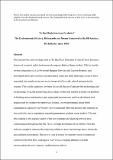Files in this item
‘Do not flush feminine products!’ The environmental history, biohazards and norms contained in the UK sanitary bin industry 1960-2020
Item metadata
| dc.contributor.author | Rostvik, Camilla Mork | |
| dc.date.accessioned | 2021-11-09T11:30:01Z | |
| dc.date.available | 2021-11-09T11:30:01Z | |
| dc.date.issued | 2021-11-01 | |
| dc.identifier | 259486915 | |
| dc.identifier | 05711e1e-e727-40fd-834a-a0206cc95753 | |
| dc.identifier | 85116155633 | |
| dc.identifier | 000700090500003 | |
| dc.identifier.citation | Rostvik , C M 2021 , ' ‘Do not flush feminine products!’ The environmental history, biohazards and norms contained in the UK sanitary bin industry 1960-2020 ' , Environment and History , vol. 27 , no. 4 , pp. 549-579 . https://doi.org/10.3197/096734019X15740974883807 | en |
| dc.identifier.issn | 0967-3407 | |
| dc.identifier.other | ORCID: /0000-0001-9916-917X/work/66807740 | |
| dc.identifier.uri | https://hdl.handle.net/10023/24296 | |
| dc.description | This research was supported by the Leverhulme Trust | en |
| dc.description.abstract | The sanitary bin and warnings such as 'Do Not Flush Feminine Products!' have become a feature of women's public bathrooms throughout Britain. Begun in the 1950s by family-owned companies such as Personnel Hygiene Services and Cannon Hygiene, and developed into large corporate systems, these items and their cleaning structures have expanded into nearly every university, hospital, office, café, school and gym in the country. This article examines the three historical phases of sanitary bin technology and its meanings. First, the pioneering phase when the bin was needed to tackle the problems of flushing menstrual products and unpopular incinerators, and was developed and popularised by creative entrepreneurs. Second, the environmental phase when campaigners, especially the Women's Environmental Network, boosted the industry as they called for more regulations regarding menstrual product waste in the 1970s and 1980s, leading to the popularisation of the bin exchange and cleaning services now commonplace throughout the UK. Third, the high-tech phase of the 2000s, when the industry sought to reinvent the object by adding no-touch technology, more chemicals and aesthetic innovations. This article thus presents the sanitary bin in its historical context for the first time, and argues that it reveals changing attitudes towards menstruation, the environment and bathroom politics. | |
| dc.format.extent | 31 | |
| dc.format.extent | 12779160 | |
| dc.language.iso | eng | |
| dc.relation.ispartof | Environment and History | en |
| dc.subject | Sanitary bin | en |
| dc.subject | Menstruation | en |
| dc.subject | Waste | en |
| dc.subject | Twentieth-Century Britain | en |
| dc.subject | Environmental Activism | en |
| dc.subject | Bathroom Politics | en |
| dc.subject | 3rd-DAS | en |
| dc.title | ‘Do not flush feminine products!’ The environmental history, biohazards and norms contained in the UK sanitary bin industry 1960-2020 | en |
| dc.type | Journal article | en |
| dc.contributor.sponsor | The Leverhulme Trust | en |
| dc.contributor.institution | University of St Andrews. School of Art History | en |
| dc.contributor.institution | University of St Andrews. Centre for Contemporary Art | en |
| dc.identifier.doi | https://doi.org/10.3197/096734019X15740974883807 | |
| dc.description.status | Peer reviewed | en |
| dc.identifier.grantnumber | ECF-2017-036 | en |
This item appears in the following Collection(s)
Items in the St Andrews Research Repository are protected by copyright, with all rights reserved, unless otherwise indicated.

